No country in the EU is home to as many farmers as Romania, and in no other country are the farms as small. Farmer Cornel Lascu is trying to keep his farm going, because, as he points out, you don’t just abandon your roots.
Sunday mornings at St. Nicholas’ church are the only real chance he gets to catch his breath. As on every other Sunday, farmer Cornel Lascu sits on the front right-hand side of the church in the men’s section on a wooden chair with a curved backrest. He has sat here so often that the varnish on the seat is starting to peel off. While the priest prays in sonorous tones in the chancel in front of Lascu, the large congregation attending mass have begun reciting “Lord, have mercy upon us” in the nave. In the fog of incense, a number of women throw themselves to the floor, the golden icons looking down on them ominously from the walls. Cornel Lascu, on the other hand, breathes in deeply, his woolly hat resting on his lap. He has been here for three hours now and the orthodox mass will last for another hour. The brawny farmer with greying hair will then leave the nave. He will make his way down the hill from the church, cross over the bridge and along a gravel road towards his house. The same route every Sunday, around one kilometre, with no traffic lights, no zebra crossings and no pavement all the way to his home, which has a number rather than an address: 239.
The two-storey building with its gable traditionally facing the street was once home to his grandparents. Lascu grew up here and he and his wife raised a daughter and a son here. The cattle will be waiting in front of the empty hayracks on Sunday, as on any other day. But now, while the parishioners intone the last “Lord, have mercy upon us”, while the heads of the women kneeling down almost seem to disappear into the stone floor, while the incense drifts up into the sinuses of the congregation, Lascu pauses for a moment. These moments are his and his alone. He once travelled to the south with his children: “So that they could see the sea”. But that was many years ago. His respite from everyday life starts with the golden pictures of saints and ends when the priest clad in silver-embroidered garments hands out communion. And he is not the only one.
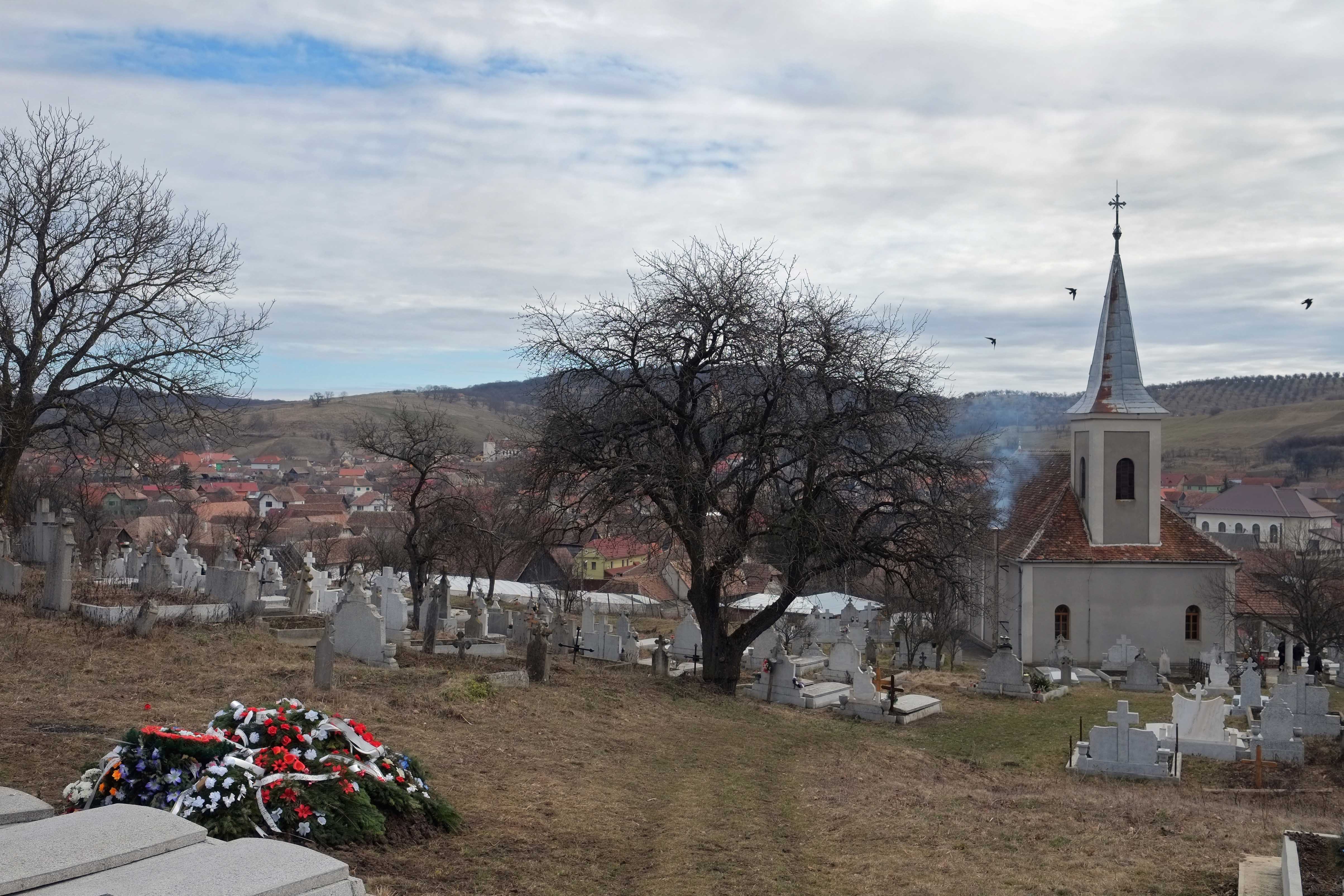
The Othodox church in Vurpăr is an important place for people in the community to meet, discuss and generally keep alive important community bonds. Photo: Mihai Stoica
The municipality of Vurpăr in Transylvania, Central Romania, 30 kilometres from Sibiu, has an official population of 2,500 residents. This number is even lower if you subtract the people who regularly go to work in Germany, Austria or France for a few months. A single lane winding over three hills leads to Vurpăr. It passes by herds of sheep searching for the first shoots in mustard-coloured winter grass before reaching the bilingual village sign next to the branch of Western Union: it reads “Vurpăr /Burgberg”. Before the revolution, Vurpăr was home to Transylvanian Saxons; around 900 families are said to have lived here. These people, whose ancestors arrived in the 13th century to defend Christianity in the buffer zone between East and West, emigrated to Germany in droves in the 1990s in search of a better life. Their fortified church was all they left behind, its tower perched on the village’s highest hill. It has looked out over the village for nearly a thousand years, out onto fields divided up into strips of land which begin where the vegetable gardens end, out onto a way of life that brings together the Saxons, the Romanians and the Romani minority in the village: agriculture.
From time immemorial, the people here have been growing all manner of vegetables, including cabbages, tomatoes and red beet, on just a few hectares, and milking their cows by hand. The poultry are free to roam the farms as they please. It is estimated that a third of the food consumed in Romania is produced by small-scale, family-run farms, using minimal equipment and a lot of muscle power – and bypassing commercial trading outlets. Instead of ending up barcoded and wrapped in plastic on supermarket shelves, the country’s harvest is sold on markets, daringly piled up in precarious mountains on market stalls and peddled in enthusiastic tones. Or in the arms of women who sit in the corners selling handfuls of carrots and bunches of parsley. No other country in the EU is home to as many farmers as Romania: every third EU farmer lives here, and nowhere else are the farms so small. 95 percent of Romania’s 3.5 million farmers cultivate land amounting to less than ten hectares; most of them have less than five. A German farmer would barely scrape by with ten hectares. In Vurpăr, this amount of land would make you a large-scale farmer.
This label does not apply to Cornel Lascu. The 46-year-old has four pigs, a handful of chickens and several hectares of fields to grow forage cereal. His wife Daniela looks after the vegetable field behind the barn. Next to the barn, Lascu’s most precious “gems” can be found behind the wooden door. This is where his four “sensitive little souls” live, which visibly fill this otherwise reserved man with pride and joy. “Just be careful. They’re easily scared,” he adds, before he presses down the wooden door handle and crosses the threshold into the darkness, murmuring a calming “shhh, shhh”. Four massive, black, harnessed heads look up from the hay and turn towards these unexpected visitors with a bewildered look: they are water buffaloes with dark eyes and elongated horns, curled backwards like pirates’ sabres, with sturdy torsos and square hooves, each animal weighing nearly a ton. Hardly any farmers go to the trouble of keeping buffaloes today. They kick when they feel under threat and will use their horns if they have to. But because they pull the plough better than any horse, because they eat things that even pigs will refuse to touch, such as corn stalk, and because their milk contains eight percent fat, which is twice as much as that of any cow, people in the region have stuck with them over the centuries.
When there was much work to be done and even more mouths to feed, the buffaloes certainly came in very handy. Today, Lascu has a tractor, which, albeit decrepit, is still in working order; his buffaloes are kept in the stable for their milk. A buffalo produces around ten litres of milk in the summer when the fodder is succulent; now, at the beginning of spring, the animals yield five litres each. Lascu’s grandfather taught him how to handle the buffaloes and he inherited two animals from him. It would never cross Lascu’s mind to switch over to cows. “I mean, I grew up with the buffaloes,” he says and shakes his head as he talks about his neighbours who have even given up their garden. Simply abandoning your roots? Unthinkable. The animals thus determine the rhythm of his daily life. He hacks the corn stalk before six in the morning, prunes the potatoes or beet, and fills up the pail with corn. He feeds the buffaloes and milks them before he has even put any food into his own belly. The second round comes after lunch. In the meantime, he mucks out the stable and the pigsty, and processes the milk. He sweeps the courtyard with his besom, clearing away the straw. He ploughs the field and mends the rusty tractor. In spring he sows the field and then brings in the harvest little by little. He makes hay in the autumn and slaughters the pig in the snow before Christmas. He rests whenever he can, rather than when he wants to.
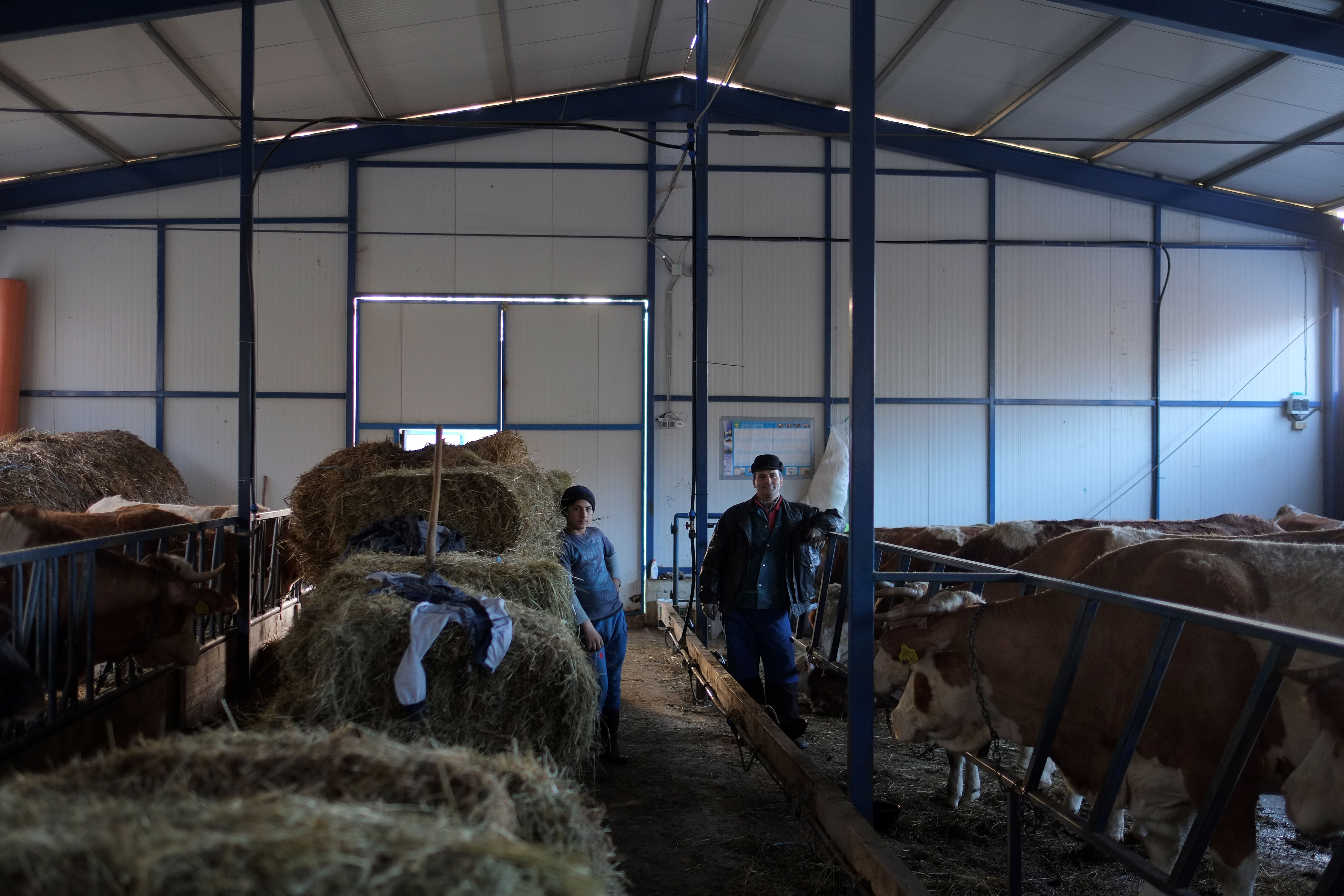
Two workers are feeding cows in a repurposed building that used to be part of a communist style cooperative. Some of the infrastruture of these cooperatives accross Romania were taken over by small farmers, while others lie abandoned. Photo: Mihai Stoica
On this afternoon in March, he has to collect wood to burn for heating. What do all these stresses and strains do to a person? Lascu lovingly strokes the bony rump of one of the buffaloes. “You have to love what you do.” Here in Vurpăr in house 239, this quote, which could come straight out of a kitsch calendar, is both Lascu’s anchor and the driving force behind everything he does. The buffalo milk ensures that the family have food on their table every day and cash for washing powder and school supplies, for clothes and medicine. A few people in Sibiu regularly buy milk from the family. To make ends meet, Lascu works as an attendant in a museum in the city two days a week. And if money gets really tight, the family sell one of their pigs. Several years ago, Lascu’s brother emigrated to Austria and now deals in car parts in Klosterneuburg. But Lascu stayed behind. Why does he stick it out here?
He is not alone in Vurpăr. Viorel Cocoș, for example, grows beef tomatoes, each weighing in at one kilogram, which are as sought-after as beer and pretzels at the village fair. He bought his house from a Saxon man back in 1999 and now waits here in his Saxon house for his wife to return from doing seasonal work in Germany. Or Johann Sonntag, who settled for Romania many years ago and now, after the death of his wife, is left with just a noble steed and a native language that barely anyone in the village understands anymore. These men and all the other farmers get by with just a few cattle, a little money, a small harvest and a whole lot of hard graft. And it is the same story elsewhere: nearly half of all Romanian small-scale farmers process their products themselves.
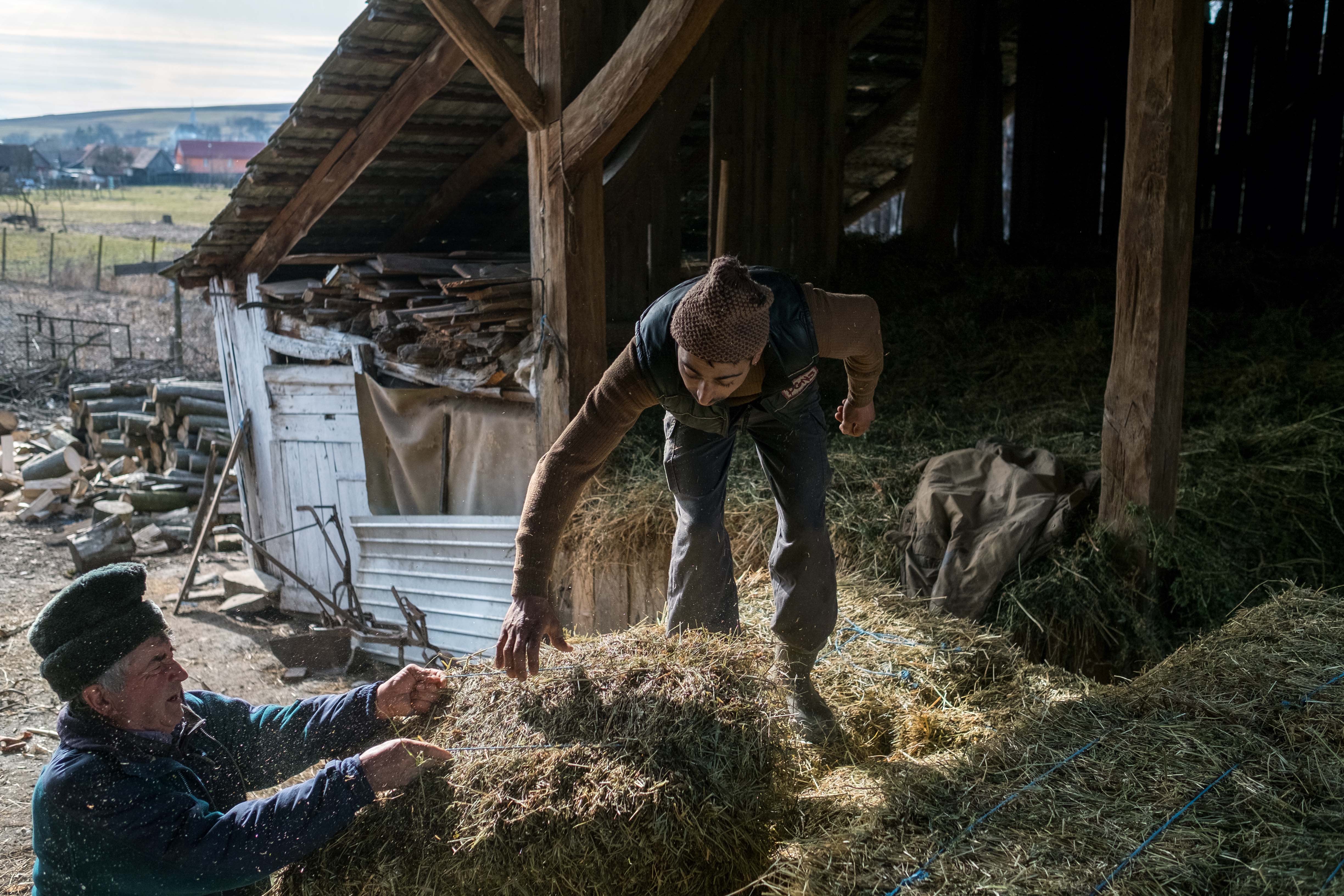
Traian Banea is helping Ioan, one of his workers, to load up a cart with hay that will be fed to the cows. Even tough he can afford to hire workers, the amount of work on the family farm requires everybody to be hands on. Photo: Mihai Stoica
However, many people are throwing in the towel, above all the young. Aside from the obvious drop in numbers that comes with the death of a farmer, the farming population overall is on the decline in Romania. It is often the prospect of a more simple existence that drives people to give up their farms – particularly if, unlike Lascu, they fail to find an income in another niche. And there are at least some alternative options here in Transylvania which do not require you to leave the country. The companies located around Sibiu, the foreign investors from the automobile and electronics industries, such as Bosch, Continental, and the Marquardt Group, are desperately looking for labour. Every day, they send shuttle buses to isolated villages to pick up workers. The unemployment rate in the district is under 2.5 percent. These buses hurtle past people like Lascu and Cocoș. Their farms are their world and in this world their gut rules over their head.
“It’s the only way we know,” says Elenoara Banea, and the women nod in agreement. They have gathered in Banea’s kitchen to bake doughnuts. The priest’s wife died a year ago and a requiem mass will be held. The women know better than to show up with empty hands. They have been huddled around the round wooden table since midday in a room with a low-hanging ceiling. A set of antlers are nestled in the domestic shrine, next to pictures of saints to protect the farm. Who will look after it otherwise? The state certainly won’t. “Quick, hand me the napkin,” calls out Elenoara Banea, known to all as simply Mrs Norica, as she fishes the first doughnut out of the enamel pan, the sizzling fat blowing bubbles in the dough. The plan is to bake 150 doughnuts this afternoon to make sure they do themselves proud at mass.
The women can allow themselves this extra shift because it is late winter. There is still time before they must sow the seeds to grow onions, spinach, garlic, lettuce, radishes, pumpkins and parsley in their gardens. The art of growing vegetables, keeping animals, their entire way of life: this is not something they learned at school. This knowledge was passed down to them from their grandparents and parents or acquired in the school of life, which certainly moves at a much slower pace here, yet without stagnating. Mrs Norica, 60 years old with a white page-boy haircut and a determined voice, grows goji berries and pays all of her bills online. But she still has to go outside to collect new logs for her stove. The screech of guinea fowl can be heard as she opens her door. “No cat will chase away the rats as good as a guinea fowl,” says one of the women. “And no gun will either.”
Life in Vurpăr follows these simple rules: guinea fowl to combat rats. Beer and salt to combat snails. The women mix fertiliser from chicken manure: three parts water, one part chicken manure. 21 days waiting time. The bulky stone oven between the living quarters and the barn has three different hearths: bread in the middle, stew on the left and schnapps on the right. The schnapps is made from produce harvested on their land and burns like hell as it slips down your throat. Women are only allowed to drink a single glass – such is the tradition across Transylvania – or their children will go blind.
Speaking of children: it is mainly the young who have decided to leave behind the rural life in Vurpăr and head to the city. For the lucky parents, this only means nearby Sibiu or perhaps Bucharest. The others equip themselves with a Wi-Fi connection and install Skype. Mrs Norica has set up a table especially for Skype conference calls with her two sons. Not unlike a little altar, it is bedecked with faded photos of her children and high-resolution pictures of the grandkids. Her older son is a doctor in Seville; her younger son is doing a PhD at the University of Reykjavik. The computer connects them all: the mother with her children and the children with their home, which may have little to offer, but it remains home, nonetheless. Her older son has even installed a camera in the courtyard, allowing him a glimpse of life on the farm from faraway: the horse-drawn cart as it comes into the courtyard to collect the hay from the barn, the brown mare picking at the strands of grass sticking out of the ground, iron studs as thick as fingers in its hooves to help it along the muddy roads, and a red pom-pom on its bridle to ward off the evil eye as chronicled in local mystical tales.
And sometimes home comes to him: Mrs Norica regularly sends food parcels to the west. She takes them to the international coach station in Sibiu and slips the bus driver a few bank notes so he will take the pickled vegetables in shatter-proof plastic jars with him on his journey. And then there are the special deliveries: a lamb at Easter, a carved-up pig at Christmas: deep-frozen meat parcels travel the length and breadth of Europe. Dispatched by Mrs Norica and many others.
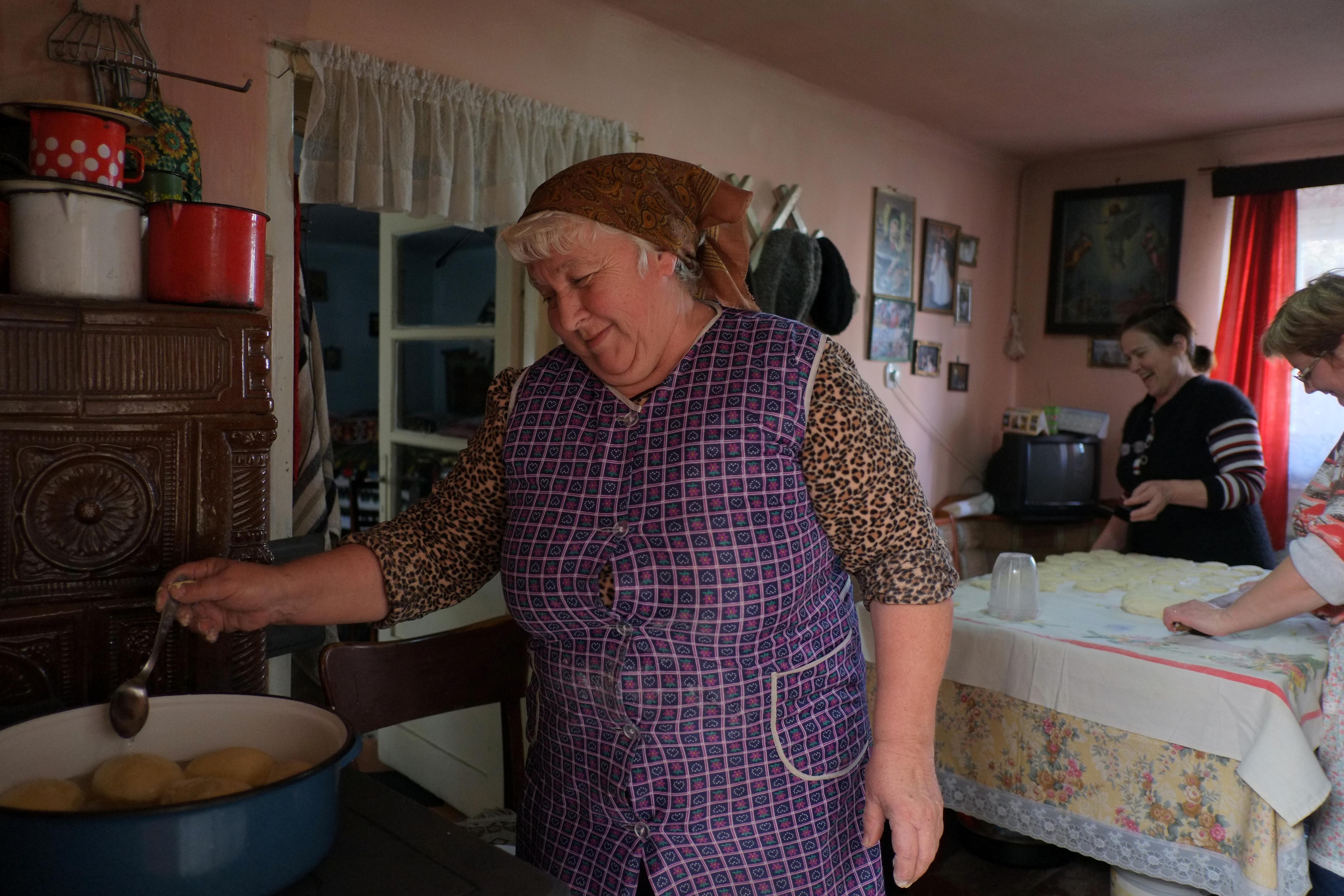
The women in Vurpăr prepare their own doughnuts for a memorial meal ahead of Orthodox Easter. Photo: Mihai Stoica
Shortly after the fall of communism, the Romanian agricultural sector generated more than one fifth of Romania’s GDP; today, it is just four percent. This is due to the realignment of the economy towards the service industry and also to the state of the Romanian agricultural sector. Supermarkets all over the country, even in the smallest towns, are filled with products imported from Western Europe, which are cheaper and above all available. In 2016, the Romanian government tried to introduce a law which would bring Romanian products into supermarkets by force, requiring 51 percent of food on the shelves to be sourced from Romania. The law was thwarted by EU regulations – Brussels believed it breached the Single Market – and the actual situation on the ground.
Cultivating the land with labour-intensive methods and little automation, using outdated equipment and low levels of pesticides may protect nature and the environment, but it is not competitive. The fact that these methods enable the continuation of village culture and give people with low pensions and meagre social benefits a security net is barely factored into the equation. On top of this, very little money from the EU trickles down to these parts: European agricultural policy primarily subsidises large plots of land and very few farmers in Romania are able to own several hectares, giving them little access to funding. 90 percent of the recipients of direct payments – the most important pillar of the EU subsidy schemes – end up with less than 1,250 euros a year. Nevertheless, in no other EU country do more people – one in four – still work in the agricultural sector.
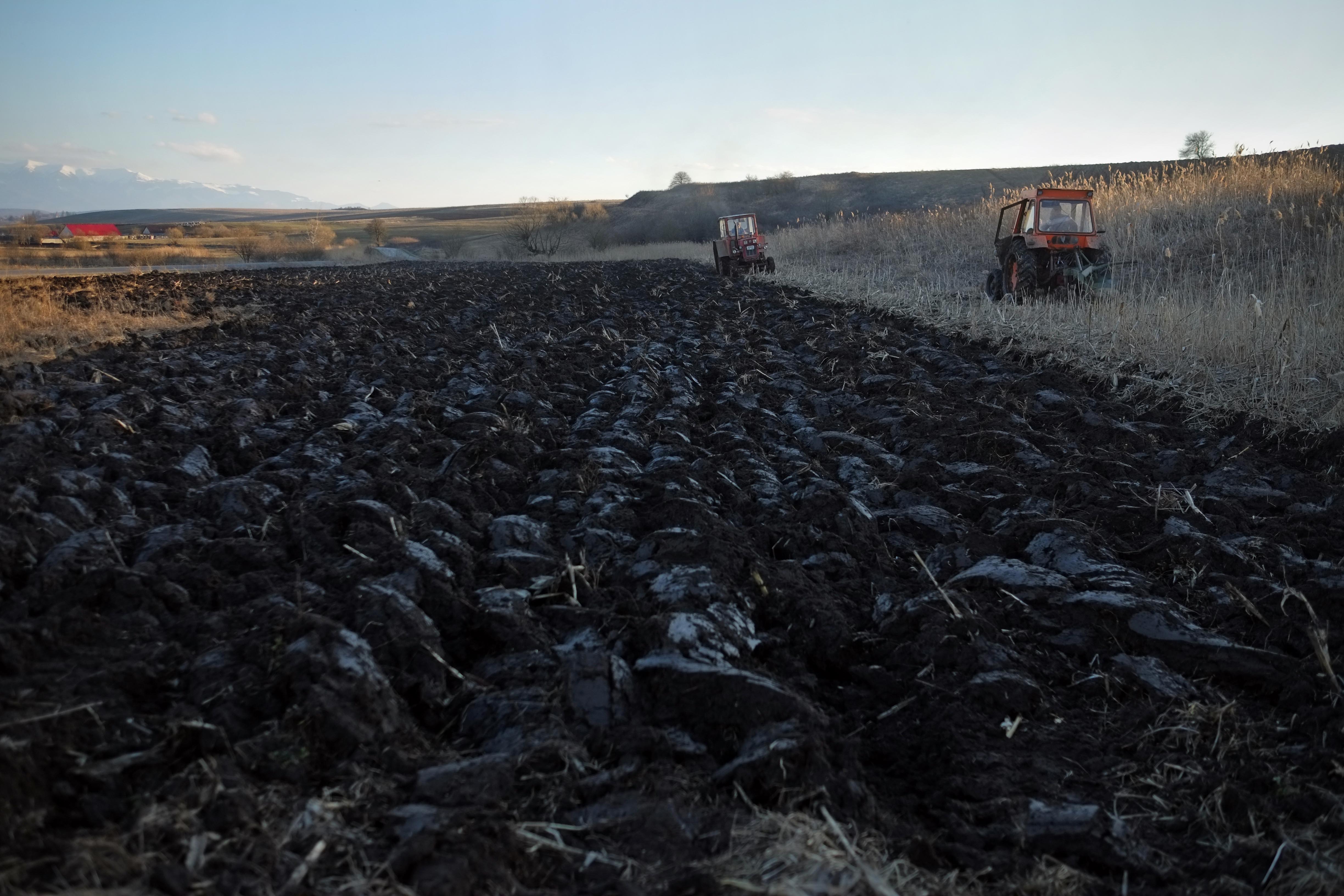
Two tractors are plowing a field early in the spring in the hills surrounding Vurpăr, Sibiu county. According to Eurostat, less than 2% of agricultural businesses own a tractor. Photo: Mihai Stoica
In Vurpăr, however, there is a shortage of labourers. On the edge of the village, where the paths peter out into the first fields, maize will soon spring from the soil and in early summer the alfalfa plants will grow lilac blossoms. The visitor may be greeted by an idyllic Transylvanian scene, but it would not exist without all the hard work put in by the local people. As modest as the farms may be, the families cannot run them on their own. They need cheap hands to help out on the field, in the stable, on the meadow. Day labourers to do the work of the missing machines and to drive the herds of cattle over the common land. They need shepherds for the mountain pastures. As far back as anyone can remember, this has been the job of the Romani people in the village. Just as Lascu learned how to be a farmer from his grandparents, the skills involved in being a farmhand were passed down over the generations to Romani children. But since the introduction of freedom of movement, giving people the chance to travel to Germany, France and Austria and earn two or three hundred euros in Western Europe with far less toil, it is mainly those with the least to lose who have turned their backs on Vurpăr. Since the Romani started to leave, the work really is never-ending.
Only in their Sunday best do they get a chance to rest. In St. Nicholas’ church on the hill, the priest has positioned himself in front of the congregation to give his sermon, signalling the final stage of the service. In the men’s section, Cornel Lascu stretches forward and sits up straight. In the women’s section at the back, Mrs Norica straightens out her elegant black stole. A veil of cold breath and mist from thick coats and incense hangs over the congregation. The path to God is a choice you make, explains the priest empathically. And the path to becoming a farmer? Lascu points out how nice it would be if he could pass down this bond to animals and to the earth to his children, just as it was passed down to him. If he could show them what it means to have one’s roots firmly in the land. His daughter already has her sights set on the farming world: to his delight, she is studying agriculture in Sibiu. His son is just 15 years old and is interested in religion. Who knows where his path will lead. Lascu has learned that it is not really possible to determine the course of life. Whatever will be, will be. When you ask Lascu what he dreams of, he doesn’t really know how to answer. And what would he change about his life? “Nothing,” he says as he shrugs his shoulders. In fact, he has never really given it much thought.
Original in German. First published on 18 May 2018 in Frankfurter Allgemeine Zeitung on faz.net.
Translation into English by Rebekah Smith.
This text is protected by copyright: © Eva Konzett. If you are interested in republication, please contact the editorial team.
Copyright information on pictures, graphics and videos are noted directly at the illustrations. Cover picture: Traian Banea is starting up his tractor on the farm. Even though the tractor is old, he says it is essential to his work and it is still very much functional. Photo: Mihai Stoica
